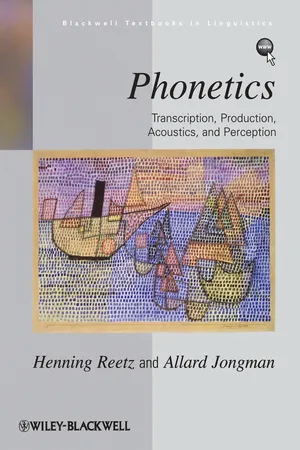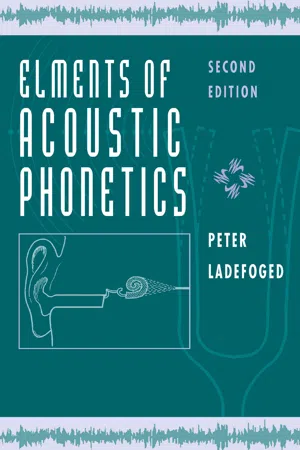Languages & Linguistics
Formant
Formants are resonant frequencies in the vocal tract that contribute to the distinct sounds of vowels and consonants in human speech. They are created by the shaping of the vocal tract and are crucial for distinguishing between different speech sounds. Formants play a key role in the study of phonetics and are used to analyze and understand the acoustic properties of speech sounds.
Written by Perlego with AI-assistance
3 Key excerpts on "Formant"
Learn about this page
Index pages curate the most relevant extracts from our library of academic textbooks. They’ve been created using an in-house natural language model (NLM), each adding context and meaning to key research topics.
- eBook - ePub
Phonetics
Transcription, Production, Acoustics, and Perception
- Henning Reetz, Allard Jongman(Authors)
- 2011(Publication Date)
- Wiley-Blackwell(Publisher)
Figure 9.9e ). By altering the center frequencies and bandwidths of the filter, which is accomplished by changing the shape of the vocal tract “tube,” different frequency regions are attenuated. Thus, the distinction between individual speech sounds is the result of the characteristic resonance frequencies of the vocal tract, which determine the specific spectral shape of the speech signal.9.5 Formants
Formants (see Section 9.4.1) are a property of the vocal tract itself, independent of whether a laryngeal source signal is present or not. This can be demonstrated by a small experiment. Move your articulators into the position for an [o], for example, but without letting any air flow from the lungs. Now tap with your finger on the larynx or the lower jaw, and you hear an [o]. If you form the sound [ɑ] with your articulators and then tap on the larynx, you hear an [ɑ]. The shape of the vocal tract determines the Formants, independent of whether there is a source signal or not. This sound source can be the oscillation of the vocal folds, or the tapping of a finger on the larynx.Even when a source signal is present, the position of the Formants is independent of the fundamental frequency of the vocal fold vibration. Since Formants are caused by the position of the articulators, and do not constitute a property of the speech signal itself, the Formant frequencies do not always correspond to the harmonics of the laryngeal signal, as can be seen in Figure 9.10 . For example, a Formant may occur at 400 Hz, while the laryngeal signal has a fundamental frequency of 90 Hz. The harmonics (F 0 = H1, H2, H3, H4, etc.) of the fundamental frequency are therefore 90, 180, 270, 360, 450, 540, 630, … Hz, but no harmonic occurs exactly at 400 Hz (Figure 9.10a ). However, the frequency of the first Formant is at 400 Hz, since it is only determined by the shape of the vocal tract. For a signal with harmonics closer together (lower F 0 ), there is a greater probability of an individual harmonic being close to or coincident with a Formant. For a higher F 0 it is less likely that a Formant frequency is close to a harmonic and the Formant frequency might not be available in the acoustic signal. This is the reason why it can be difficult to distinguish the vowels from each other when listening to high voices (for example, female singers or children; see Figure 9.10b - eBook - ePub
- Nigel Hewlett, Janet Mackenzie Beck(Authors)
- 2013(Publication Date)
- Routledge(Publisher)
chap. 18 .)This chapter relies on facts and concepts introduced in Parts I and II of this book. It explains the link between vocal tract shapes (described in Part I) and the acoustic structure of speech sounds (described in Part II). Chapters 3 and 11 are especially relevant. Two major works, Fant (1960 ) and Stevens (1998 ), have been extensively consulted in the writing of this chapter. Other useful sources include Borden, Harris, and Raphael (2003 ), Johnson (2003 ), Kent and Read (1992 ), and Lieberman (1977).Source and Filter
Vocal fold vibration produces a complex periodic wave, which has a fundamental frequency and harmonics that are multiples of the fundamental (see chap. 11 ). Figure 17.1 (a) shows a spectrum of vocal fold vibration, which is often called theglottal spectrum. The fundamental frequency of this sound (the one in Fig. 17.1 ) is 100 Hz. There is aroll-offof 12 dB/octave, that is, the harmonics reduce in amplitude by 12 dB with every successive octave. This is the only variation of amplitude with frequency; there are no peaks or troughs in this spectrum. The sound with this spectrum forms the input to the vocal tract tube, at the larynx. It is modified by passing through the vocal tract: notably, a series of peaks and troughs are formed. Figure 17.1 (b) shows the transfer function (cf. chap. 13 ) of the vocal tract when it forms a relatively open tube but with a constriction in the palatal region. Given an appropriate input (such as that of Fig. 17.1 [a]), this transfer function produces the vowel [i], with its low first Formant and high second Formant. The output spectrum is shown in Fig. 17.1 (c). This output spectrum reproduces the shape of the transfer function quite well. The harmonics of the source are close together and so the peaks in the output spectrum replicate the peaks of the transfer function faithfully. (If thef0 had been 400 Hz, say, the situation would be different: The first peak would not appear in the output spectrum and the higher peaks would be less well defined.) The peaks in the output spectrum reduce in amplitude with increasing frequency, as would be expected given the roll-off in the input spectrum. Actually, the output spectrum suggests a less severe roll-off than would be expected from looking at the glottal spectrum of Fig. 17.1 (a). This is because a further factor has been taken into account in Fig. 17.1 - eBook - ePub
- Peter Ladefoged(Author)
- 2017(Publication Date)
- University of Chicago Press(Publisher)
In an introductory book such as this, it is convenient to think of it in terms of simple tubes and separable cavities. But descriptions made in this way are always gross simplifications. Anyone who looks at actual acoustic records of speech will rapidly find Formant frequencies and other resonances that cannot be explained by these notions. What has been said here will do little more than help you start to understand the acoustics of speech production.


